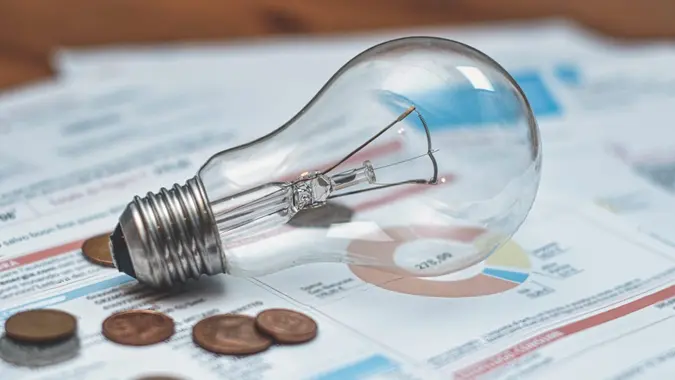3 Common Barriers Americans Face When Trying To Lower Their Electricity Bills

Commitment to Our Readers
GOBankingRates' editorial team is committed to bringing you unbiased reviews and information. We use data-driven methodologies to evaluate financial products and services - our reviews and ratings are not influenced by advertisers. You can read more about our editorial guidelines and our products and services review methodology.

20 Years
Helping You Live Richer

Reviewed
by Experts

Trusted by
Millions of Readers
More than half of Americans worry about affording their power bills in 2025, according to a recent survey from Arbor, an app that helps people save money on their electricity bills. The survey found that electricity costs ranked as the No. 2 most stressful household expense, just behind rent or mortgage payments. In addition, 41% of Americans said they have occasionally lost sleep over their power bill.
Yet, many Americans feel powerless when it comes to lowering their bills. Here are some of the common barriers Americans face when trying to lower their electricity bills.
Not Being Able To Switch To Energy-Efficient Appliances
Buying new appliances may be financially out of reach for many Americans. Nearly one-third (32%) of Americans surveyed said the upfront price of energy-efficient appliances is a barrier to lowering bills.
“There are a wide array of incentives that can significantly reduce the cost of upgrading,” said Owen Quinlan, head of data at Arbor. “Check out resources like Rewiring America, which compiles federal, state and local programs that offer rebates or tax credits for everything from smart thermostats to new HVAC systems.
“Even smaller steps, like installing a smart thermostat, can make a noticeable dent in your bill and often qualify for rebates,” he continued.
The survey found that 56% of Americans have cut back on energy use to manage costs versus just 21% who have invested in energy-efficient appliances. However, paying the larger upfront cost to switch to efficient appliances is usually worth the investment.
“Lower monthly bills help offset the initial investment over time,” Quinlan said. “Upgrading to energy-efficient appliances can be a game-changer in the long run, especially if you take advantage of federal, state or local incentives that help offset the upfront cost.”
In addition, cutting back on electricity use is often quite challenging.
“Using less power is often the easiest first step because it directly lowers the number of kilowatt-hours you’re billed for. Of course, that means changing your habits and sacrificing comfort, which isn’t always practical,” Quinlan said.
Having Little Control Over What You’re Being Charged
While Americans can swap out their appliances and lower their personal energy usage, 51% said their lack of control over energy prices is the main challenge to lowering their bills.
“You might not set your local utility’s rates, but you still have options,” Quinlan said. “First, check if you live in one of the 13 states with deregulated energy markets. If you do, you can get a lower supply rate. If you’re not in a deregulated market, ask your utility [provider] about different rate plans, like time-of-use pricing, which could save you money if you run appliances during off-peak hours.
“You can also look for community solar programs in your area, which usually provide a guaranteed bill discount of around 5% to 10%,” he continued.
Not Knowing Where To Start
Even though many Americans are stressed about their energy bills, 22% said that they simply don’t know how to lower them. However, there are a few easy steps anyone can take.
“Cooling and heating your home is usually the biggest driver of energy consumption, so if you can move the thermostat set point, you can start to lower your energy consumption,” Quinlan said. “You can also start to familiarize yourself briefly with what options you have in your market, and examine your rate — how much you are paying per kWh of electricity you use.
“If you’re in a deregulated state, explore lower-rate options or consider services like Arbor that automatically find competitive rates for you,” he continued. “If your state is not deregulated, see if your utility offers multiple billing plans that can reward you for shifting usage away from peak periods. That single step — knowing and adjusting your rate — can immediately start saving you money.”
 Written by
Written by  Edited by
Edited by 

























